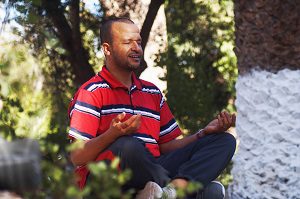Audrey Folsom, DHSc, MSHS, MT(ASCP)
 |
| Photo credit: Abdrahim Oulfakir, Unsplash |
Stress is an inevitable part of life. Some stresses are desirable, such as the birth of a child; some are undesirable, such as the loss of a loved one. Situations such as the novel coronavirus pandemic increase stress and anxiety due to the uncertainty it creates. When faced with uncertainty, our default reaction is to experience fear and anxiety, and turn on the “fight, flight, or freeze” response, which causes the brain to turn to the amygdala for decision making. This makes us more reactive and causes us to behave poorly or make unwise decisions. The amygdala is a preverbal part of the brain, which is why it is impossible to tell yourself to relax and actually make it happen. The stressed part of your brain cannot understand language. This can make us stuck in the sympathetic part of the nervous system until the threat subsides. (Fletcher, 2019, p. 37)
If language will not work, how does one communicate with the amygdala and turn off this sympathetic “fight or flight” response? The answer is rather simple: turn on a parasympathetic response. The parasympathetic nervous system is the one in charge of digestion, rest, and relaxation. This is why, when stress strikes, it is hard to sleep well, e.g., “tired and wired,” and why many experience digestive issues while under stress. The simplest way to turn on a parasympathetic signal is to double the length of your exhale while breathing. This signals the brain that everything is fine, and you are safe.
“I had more clarity of thought, my occasional brain fog had lifted, and I felt more present in my life and less bothered by annoyances.”
It can be as simple as breathing in for a count of two and breathing out for a count of four, which may be all you can manage if you are really anxious. I have found that any number between two and five can work for the inhale, as long as the exhale is doubled (for example, in for four, out for eight). This can be done with eyes open or closed and should be done for 15 cycles or about three minutes. Then, think of three simple things for which you are grateful. This nails it in because it is impossible to be afraid and grateful at the same time. This can be done anytime it is needed, multiple times a day. (Fletcher, 2019, pp. 37-38)
Meditation has become an invaluable tool in my stress-fighting belt. I ventured into the practice of meditation a couple of years ago. It took me a while to find a meditation practice that I would do for more than a week or two. The first one that stuck was Vishen Lakhiani’s six-phase meditation. Vishen is the author of The Code of the Extraordinary Mind and The Buddha and the Badass and the founder of Mindvalley, an education site with the mission of teaching the world the art of truly living extraordinary, fulfilling, happy lives (Lakhiani, n.d.). A quick search for “6-phase meditation” on YouTube can get you started. He also has a free meditation course on Mindvalley.
I used this technique for more than six months with great results. I had more clarity of thought, my occasional brain fog had lifted, and I felt more present in my life and less bothered by annoyances. I credit this practice with getting me through the process of my doctoral dissertation without suffering a mental breakdown. Then, I ran across the work of one of Vishen’s students, Emily Fletcher, author of Stress Less, Accomplish More, and founder of Ziva Meditation. I read it over Christmas break 2019. In retrospect, it was as if God (or the universe) said, “Read this, you are going to need it shortly!”
Emily’s meditation practice resonated with me more deeply than Vishen’s, but I can also see the similarities between them. In her book, Emily provides the practical tools to upgrade personal and professional performance, no matter who you are. The book version of the meditation technique is called the Z-technique and has become an integral part of my daily routine. It has decreased my stress level, increased my energy, given me deeper and more restorative sleep, increased my creativity and adaptability, and lengthened the time I can spend in focused work.
It only takes 15 minutes, twice a day. And, if you think you don’t have time, try it anyway because you will gain those 30 minutes right back (and more) in increased productivity. If you object on the count that you can’t clear your mind, then the Z-technique is for you because it doesn’t require you to clear your mind. This is because “it is as impossible to will your mind to not think as it is to will your heart to not beat.” (Fletcher, 2019)
If you want to build resilience to stress into your life, I highly encourage you to pick one of the aforementioned books, start a daily meditation practice, and learn simple breathing techniques. These practices will help you shed stress from your past, deal with stress in the present, and visualize goals for your future.
Audrey Folsom is an Assistant Professor, Clinical Laboratory Science, at Arkansas State University in Jonesboro. She can be found on Instagram @audreylovesoilsandscience.
